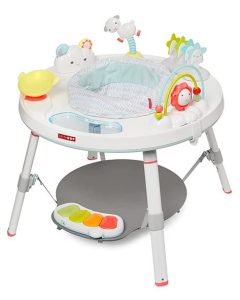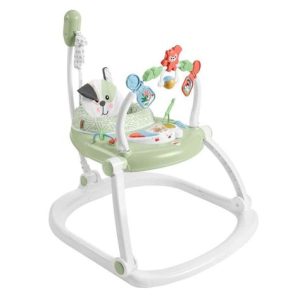Activity seats are stationary seats designed for babies, often from around 4 to 12 months old. They provide a safe and stimulating environment for little ones to play, explore, and develop new skills. This article dives into the world of activity seats, exploring their benefits, different types, and factors to consider when choosing one for your baby.
The Perks of Playtime in a Seat
Activity seats offer several advantages for both babies and parents:
Engaged playtime:
Activity seats come with a variety of toys, sounds, and textures to keep babies entertained and stimulated. This allows for independent playtime, giving parents a short break.
Developmental benefits:
Activity seats can help promote motor skills, hand-eye coordination, and sensory development through play.
Safe exploration:
Activity seats provide a safe and contained space for babies to move around and explore their surroundings.
Support and comfort:
Many activity seats offer a comfortable and supportive upright position for babies, helping them strengthen their neck and back muscles.
Activity seats can be a valuable tool for keeping babies happy and engaged, while also promoting their development.

Finding the Right Activity Seat for Your Baby
With a variety of activity seats available, choosing the right one can seem daunting. Here are some key factors to consider:
Age and weight limits: Make sure the activity seat is suitable for your baby’s age and weight range.
Sturdiness and stability: Choose a seat with a wide, stable base to prevent tipping.
Seat adjustability: Some seats offer adjustable heights or reclining options for added comfort.
Toys and features: Look for a seat with a variety of engaging toys, textures, and sounds to keep your baby interested.
Harnesses and straps: Ensure the seat has a secure harness system with multiple straps to keep your baby safely in place.
Tip: Look for activity seats with removable toy bars or trays for easy cleaning.
Keeping Your Activity Seat Fun and Safe
By following these tips, you can get the most out of your activity seat and ensure your baby has a fun and safe playtime experience:
Supervision is key: Never leave your baby unattended in an activity seat.
Rotate the toys: Switching out the toys periodically helps keep your baby engaged and stimulated.
Limit screen time: Activity seats are not replacements for floor time or tummy time.
Clean the seat regularly: Wipe down the activity seat and toys regularly to prevent the spread of germs.
With a little care and attention, activity seats can be a safe and fun way to keep your baby entertained and engaged during their first few months.

Beyond the Basics: Exploring Different Activity Seat Options
Activity seats come in a variety of styles and functionalities to suit your needs:
-
Stationary seats: These classic activity seats offer a stable base and a variety of toys for playtime.
-
Bouncer seats: These seats bounce gently, providing a soothing motion for some babies.
-
Spin and swivel seats: These seats allow babies to spin 360 degrees, giving them a wider view of their surroundings.
-
Folding seats: These portable seats fold up for easy storage or travel.
Consider your baby’s preferences and your lifestyle when choosing an activity seat. There’s a perfect option out there to keep your little one happy and entertained!
In conclusion, activity seats offer a safe and stimulating environment for babies to play and explore. By understanding the benefits, different types available, and considering key factors when choosing one, you can find the perfect activity seat to support your baby’s development and bring smiles during playtime. So relax, and enjoy watching your baby explore and learn in their own fun little world!
Making the Most of Activity Seats
Activity seats can be a valuable tool for keeping your baby happy and engaged, while also promoting their development. Here are some additional things to consider:
Developmental stages: As your baby grows, their needs and interests will change. Look for an activity seat that offers a variety of features to keep them engaged at different stages.
Music and sounds: Some activity seats come with music and sound effects. Choose calming melodies or nature sounds to create a soothing environment for your baby.
Bright colors and patterns: High-contrast colors and patterns can help stimulate your baby’s vision.
Cleaning and maintenance: Follow the manufacturer’s instructions for cleaning the activity seat and toys to keep them sanitary.
-
Interactive play: When your baby is in the activity seat, talk to them, sing songs, and make silly faces. This interactive play helps with your baby’s development and strengthens your bond.
-
Variety is key: Rotate the toys in the activity seat regularly to keep your baby interested. You can also provide them with safe, age-appropriate objects to explore from around the house.
-
Reading time: Reading to your baby, even if they seem too young to understand, is a wonderful way to bond and stimulate their brain development. Curl up with your baby in a comfy spot for story time.
-
Playtime routine: Incorporate activity seat time into your baby’s daily routine. This can help them develop a sense of predictability and schedule.
-
Finding the fun: Observe your baby and see what toys and features capture their interest the most. This will help you get the most out of the activity seat and keep playtime engaging.
-
Sharing playtime: When you can, sit on the floor and interact with your baby while they’re in the activity seat. Talk to them, sing songs, and make silly faces to keep them engaged. This social interaction is important for your baby’s development.By considering these factors, you can create a fun and stimulating play environment for your baby in their activity seat.

The Activity Seat Journey
Activity seats are a temporary but beneficial gear for most babies. Here’s a general timeline to keep in mind:
-
Around 4 months: This is when many babies can start using an activity seat, with good head and neck control.
-
Up to 12 months: Most babies will outgrow their activity seat by around 12 months when they become more mobile and want to explore their surroundings.
Remember, activity seats are not meant to be used for extended periods. It’s important for babies to have plenty of floor time and tummy time to develop their muscles and coordination.
Always supervise your baby closely whenever they are in an activity seat.
With a little planning and supervision, activity seats can be a safe and fun way to keep your baby entertained and engaged during their first few months.


